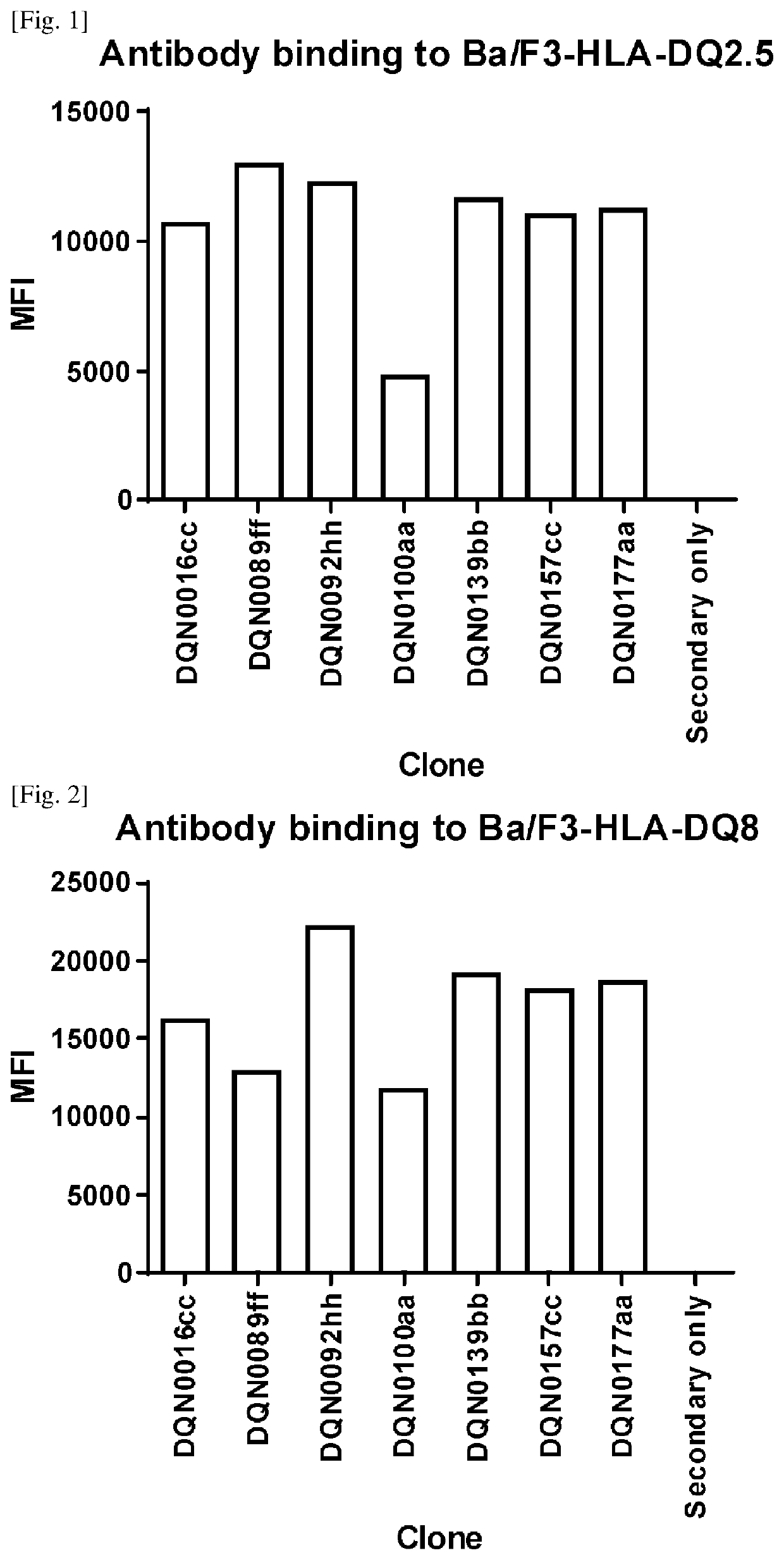Anti-hla-dq2.5/8 antibody and its use for the treatment of celiac disease
a technology of anti-hladq and anti-celiac disease, which is applied in the field of anti-hladq2 . 5/8 antibodies, can solve the problems of difficult to completely eliminate gluten exposure, no remarkable therapeutic advances, and celiac disease symptoms
- Summary
- Abstract
- Description
- Claims
- Application Information
AI Technical Summary
Benefits of technology
Problems solved by technology
Method used
Image
Examples
example 1
[0237]Expression and Purification of Recombinant Proteins
[0238]1.1. Expression and Purification of Recombinant HLA-DQ2.5 / 33Mer Gliadin Peptide
[0239]The sequences used for expression and purification are: HLA-DQA1*0501 (Protein Data Bank accession code 4OZG; IMGT / HLA accession No. HLA00613) and HLA-DQB1*0201 (Protein Data Bank accession code 4OZG; IMGT / HLA accession No. HLA00622), both of which have a CAMPATH-1H signal sequence: MGWSCIILFLVATATGVHS (SEQ ID NO: 67). HLA-DQA1*0501 has C47S mutation, GGGG linker (SEQ ID NO: 68) and c-fos leucine zipper sequence (PNAS, 1998 Sep. 29; 95(20): 11828-33) and a Flag-tag on the C-terminus of HLA-DQA1*0501. HLA-DQB1*0201 has 33 mer gliadin peptide sequence: LQLQPFPQPELPYPQPELPYPQPELPYPQPQPF (SEQ ID NO: 69), and factor X cleavage linker (Acta Crystallogr Sect F Struct Biol Cryst Commun. 2007 Dec. 1; 63(Pt 12): 1021-1025.) on the N-terminus of HLA-DQB1*0201, GGGGG linker (SEQ ID NO: 70) and c-jun leucine zipper sequence (PNAS, 1998 Sep. 29; 95(20...
example 2
[0251]Establishment of Ba / F3 Cell Lines Expressing HLA-DQ2.5, HLA-DQ8, HLA-DR, HLA-DP, and cynomolgus monkey MHC-DQ allele #1, #2, and #3
[0252]HLA-DQA1*0501 cDNA (IMGT / HLA accession No. HLA00613), HLA-DQA1*0301 cDNA (IMGT / HLA accession No. HLA00608), HLA-DRA1*0101 cDNA (GenBank accession No. NM_019111.4), or HLA-DPA1*0103 cDNA (IMGT / HLA accession No. HLA00499) was inserted into the expression vector pCXND3 (WO / 2008 / 156083).
[0253]HLA-DQB1*0201 cDNA (IMGT / HLA accession No. HLA00622), HLA-DQB1*0302 cDNA (IMGT / HLA accession No. HLA00627), HLA-DRB1*0301 cDNA (IMGT / HLA accession No. HLA00671), or HLA-DPB1*0401 cDNA (IMGT / HLA accession No.HLA00521) was inserted into the expression vector pCXZD1 (US / 20090324589).
[0254]Three different cynomolgus MHC-DQA (SEQ ID NO: 77 for allele #1; and SEQ ID NO: 79 for alleles #2 and #3) and DQB (SEQ ID NO: 78 for allele #1; SEQ ID NO: 80 for allele #2; and SEQ ID NO: 81 for allele #3) sequences was read by PCR from cynomolgus monkey PBMC, and the expressi...
example 3
[0257]Generation of Anti-DQ2.5 Antibodies
[0258]Anti-DQ2.5 antibodies were prepared, selected and assayed as follows:
[0259]NZW rabbits were immunized intradermally with HLA-DQ2.5 / 33 mer gliadin peptide. Four repeated doses were given over a 2-month period followed by blood and spleen collection. For B-cell selection, biotinylated HLA-DQ2.5 / 33 mer gliadin peptide was prepared. Antigen binding B-cells were stained with the biotinylated antigen, sorted using a cell sorter and then plated and cultured according to the procedure described in WO2016098356A1. After cultivation, the B-cell culture supernatants were collected for further analysis and the B-cell pellets were cryopreserved.
[0260]Specific binding to antigen was evaluated by ELISA using the B cell culture supernatants. The results showed that 9,841 B cell lines exhibited binding to HLA-DQ2.5 / 33 mer gliadin peptide.
[0261]We have also characterized binding to HLA-DQ8 by cell-based ELISA according to the procedure described in BioTe...
PUM
| Property | Measurement | Unit |
|---|---|---|
| dissociation constant | aaaaa | aaaaa |
| dissociation constant | aaaaa | aaaaa |
| dissociation constant | aaaaa | aaaaa |
Abstract
Description
Claims
Application Information
 Login to View More
Login to View More - R&D
- Intellectual Property
- Life Sciences
- Materials
- Tech Scout
- Unparalleled Data Quality
- Higher Quality Content
- 60% Fewer Hallucinations
Browse by: Latest US Patents, China's latest patents, Technical Efficacy Thesaurus, Application Domain, Technology Topic, Popular Technical Reports.
© 2025 PatSnap. All rights reserved.Legal|Privacy policy|Modern Slavery Act Transparency Statement|Sitemap|About US| Contact US: help@patsnap.com



